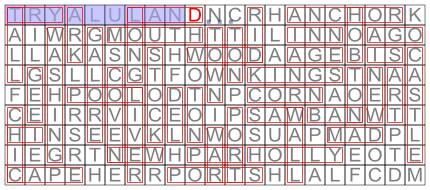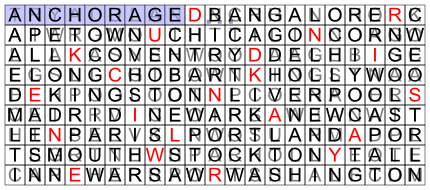
CISRA Puzzle Competition 2012 - Solutions
5A. Grid Plan
This puzzle begins as a fairly standard word search, with words to be found horizontally and vertically.
It emerges that as more words are found, pairs of words can be combined into place names. Nearly all are cities, as hinted at by the puzzle title, and all are either notable places, or places in Australia. Armed with this insight, the few words that can't be formed into place names can be rejected, and the solved grid can be completed:

The place names formed are (shown hyphenated to indicate the two separate words found in the grid):
- Anchor-age
- Ban-galore
- Cape-Town
- Chic-ago
- Corn-wall
- Coven-try
- Del-hi
- Gee-long
- Hob-art
- Holly-wood
- Kings-ton
- Liver-pool
- Mad-rid
- New-ark
- New-castle
- Par-is
- Port-land
- Ports-mouth
- Stock-ton
- Tall-inn
- War-saw
- Washing-ton
The left-over letters spell a hidden message:
LUNCH KILLS HALF OF PARIS, SUPPER THE OTHER HALF - CDM
This is a quote by Charles de Montesquieu, a French social commentator during the 1700s. This quote serves at least three purposes: It's a hint that joining halves of place names together is the correct step, a confirmer that the correct words have been identified from the grid, and a direct clue to the "PAR + IS" formation of one of the place names to be found, which is tricky to spot given the two-letter length of "IS".
The next step involves extending the blue shaded pattern that can be seen at the top-left of the grid. It is possible to observe that the total letters in place names, plus enough space characters to fit between them all, exactly equal the number of letters in the grid. Further, if the place names are sorted alphabetically, the first place name fits exactly into the blue shaded squares. The subsequent ellipsis indicates continuing the placement over the whole grid.
The initial blue shaded tiles in the grid anagram to "naturally", which can either be taken as a hint to sort the place names in the "natural" (alphabetical) order, or as a completely unintential accident of puzzle creation.
Fitting the sorted place names into the grid results in the following:

The letters that fall between the gaps of the place names produce a second hidden message:
DRUNK DICKENSIAN LAWYER
A fourth purpose of the first hidden message Paris is to put you into the mindset of Paris in the 1700s - the time period, and one of the titular cities, of one of Charles Dickens' most famous novels, A Tale of Two Cities. One of the two principal characters is a barrister and a drunkard named SYDNEY CARTON. The fact that half of the character's name is a place name fits the puzzle theme of cities, while his last name is a word made of two smaller words joined together.